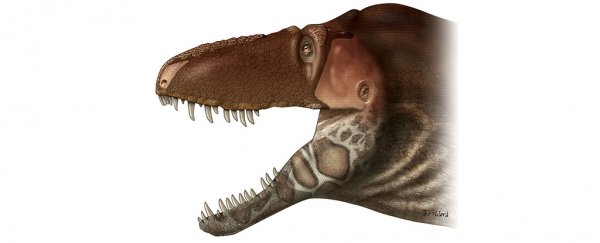Scientists have discovered a new tyrannosaur species that lived 75 million years ago on the plains of what is now Montana, and it's given us a brand new perspective on what the faces of tyrannosaurs looked like, including the iconic Tyrannosaurus rex.
Turns out, they were a lot more sensitive than we expected, and they carried the same nerves that make some of us sneeze when we stare into bright sunlight.
The newly discovered predator has been named Daspletosaurus horneri. It was approximately 9 metres (29.5 feet) long, 2.2 metres (7.2 feet) tall, and all things considered, pretty weird.
For one thing, it followed an unusual form of evolution called anagenesis - when an older species gradually goes extinct by turning into a new species.
Using radiometric dating, a team lead by Thomas Carr from Carthage College in Wisconsin established that before D. horneri emerged and started terrorising its prey - smaller dinosaurs including theropods and hadrosaurs - its older relative was a separate species, D. torosus.
"When we consider the geological ages of the two species, the evolution of Daspletosaurus gives us an indication of how slowly evolution can act on large dinosaurs, which in this case happened over a span of 2.3 million years," says Carr.
This evolutionary path makes the new tyrannosaurus special, though not unique. The researchers point out that anagenesis has also been found in some duck-billed dinosaurs and horned dinosaurs.
Not only has the specimen revealed unusual evolutionary paths - it's also allowed researchers to reconstruct the face of D. horneri with such precision, it has literally changed the face of tyrannosaurs as we know them.
Consisting of two complete skulls and skeletons, a partial lower jaw and a scattering of other bones, the fossil record available for reconstructing D. horneri was pretty much a palaeontologist's dream.
The team was able to model the face of the new tyrannosaur with incredible detail, including the large, flat scales around the mouth, patches of thick, armour-like skin, horns in front of its eyes and a highly sensitive snout.
It's crazy that this much detail of the face was gathered from bone surfaces, but as Michael Greshko explains at National Geographic, "living bone is shaped by the matrices of muscle, nerves, and blood vessels that constantly bump up against and nourish it".
All these tissues leave an impression on the fossilised bone, which then give hints to the researchers about what the long-extinct creature would have looked like in the flesh.
Still, to piece together the portrait of the predator, researchers had to go beyond their field of study and compare their findings with anatomy from the closest living relatives of dinosaurs - birds and crocodilians.
They found a complex web of facial nerves, surprisingly similar to what can be found underneath the skin of crocodiles today.
The researchers suggest that having a super-sensitive snout would have been useful for the ancient nest-building predators to pick up eggs and baby tyrannosaurs. They may have even rubbed their noses together as a sort of foreplay.
"Our finding of a complex sensory web is especially interesting because it is derived from the trigeminal nerve," says one of the team, anatomist Jayc Sedlmayr from the New Orleans School of Medicine.
"[It] has an extraordinary evolutionary history of developing into wildly different 'sixth senses' in different vertebrates."
The trigeminal nerve in the tyrannosaur's face is the same one that collects sensory information through whiskers in many animals, and also makes some people sneeze in bright sunlight.
"In some ways, the facial components of the trigeminal nerve of these dinosaurs mirrors that of humans," says Sedlmayr.
"It brings back sensation from our facial muscles, allowing us to fine tune and coordinate the emotional and social displays so important to human communication."
While the prehistoric predators didn't used their scaly snouts to talk about feelings, the idea of two tyrannosaurs rubbing their faces before going to town with each other is pretty fun to imagine.
The study was published in Scientific Reports.
